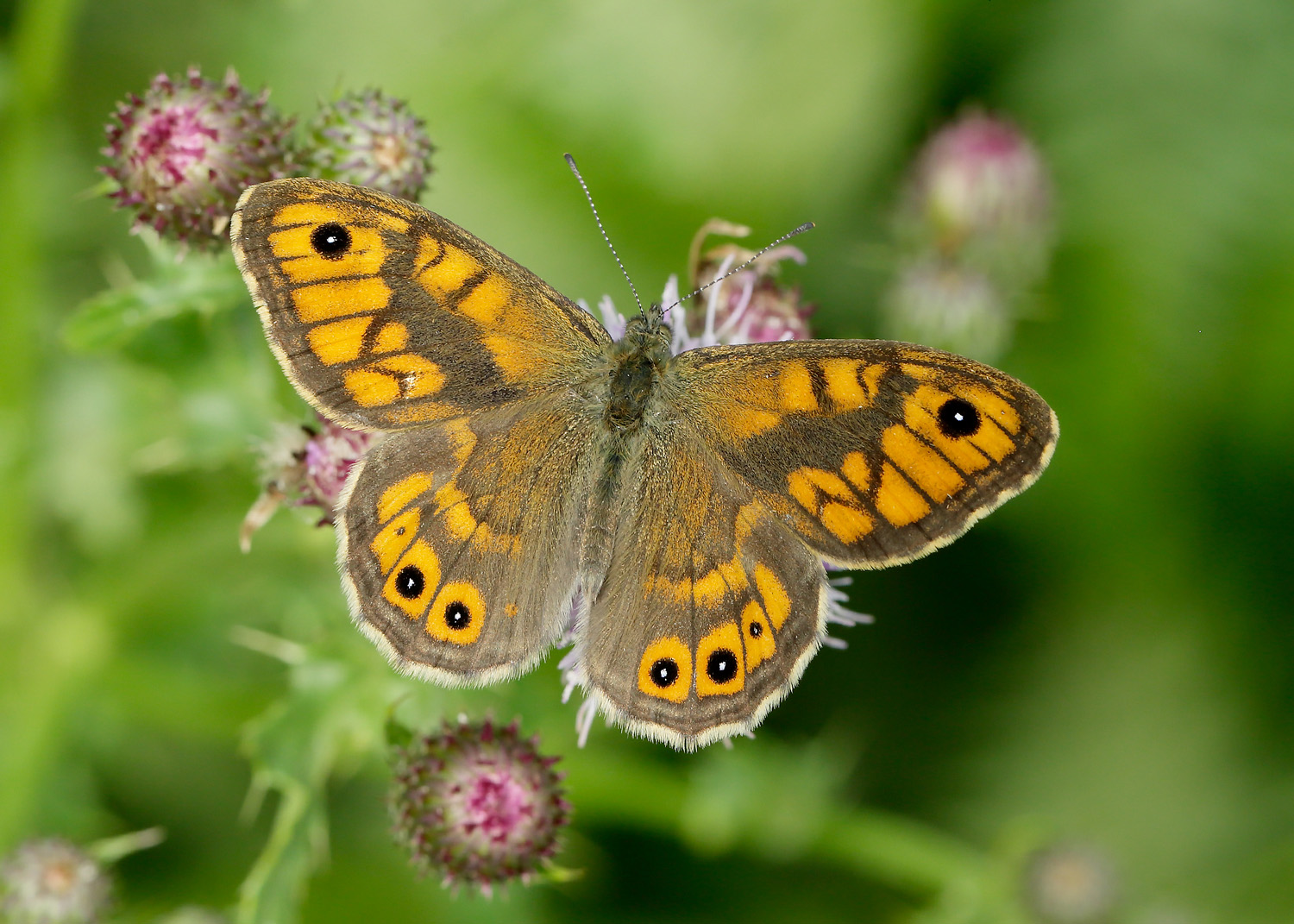
Midsummer’s here and the garden’s struggling, due to the hottest June since 1976. I remember 1976, with mixed feelings. I was pregnant with my youngest daughter Zoe, having had my oldest one in July 1975 in equally scorching weather. In fact, I have history with high temperatures, because my mother always said (through slightly gritted teeth) that I was born on the hottest day of the year at Hillingdon Hospital in outer London. Thanks to the magic of the internet, I’m able to tell you that it was 24C on that auspicious July day in 1950. That would be considered small beer today, because London has just seen 36C and experienced tropical nights of 20C. Subtext being, it could have been MUCH worse mum – honest!
Thankfully it’s been a tad cooler in the high reaches of The Cotswolds where I garden. Climate change is definitely with us though, even here in Cold Aston, and it seems to have accelerated within the last 20 years. We gardeners have noticed earlier springs, hotter summers and more clement winters and that’s making plants flower earlier than they did. Viticella clematis for instance, which used to be at their peak in July, are out in June these days. Strawberries, traditionally ripe in Wimbledon fortnight, are now picked in late May in my garden. Buddleja davidii used to liven up early August, just when the red admirals and peacocks were around in droves. These days mine comes out in July. The butterflies have been slower to adapt to climate change so very few manage to benefit from the honey-rich nectar these days, although I still love the way the sweet scent wafts over the path.
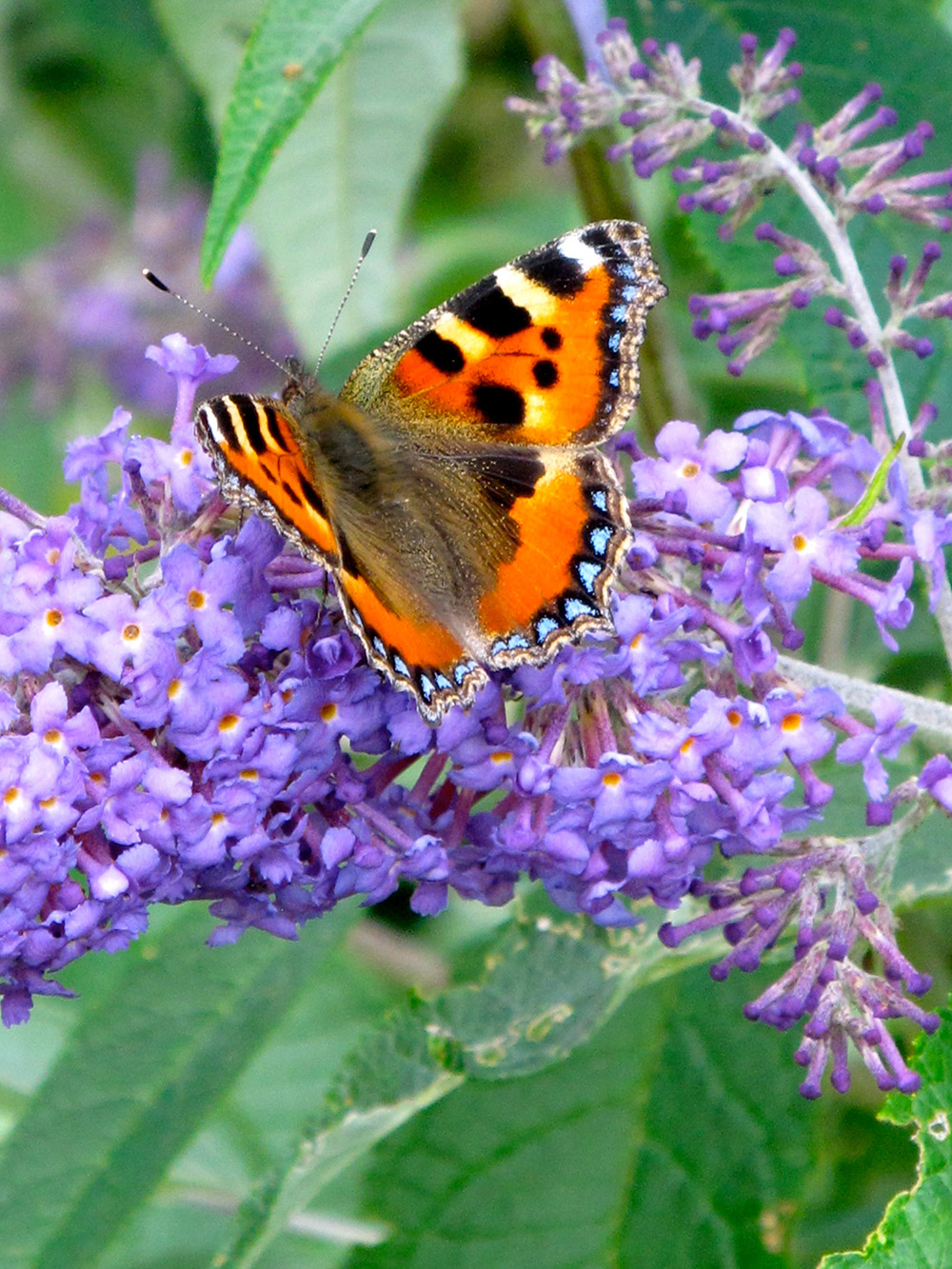
c. Val Bourne
In theory this Chinese buddleia could attract 22 species of British butterflies, making it the most butterfly friendly plant of all. That was when it flowered at the right time though. I’ve deliberately planted a later-flowering hybrid named B. x weyeriana ‘Pink Pagoda’ to try to get August flowers to satiate the butterflies. The orange-eyed pink flowers form clusters, rather than pointed flower heads. ‘Pink Pagoda’ was raised by Hampshire plant breeder Peter Moore of Longstock Park Nursery fame. They hold a Plant Heritage collection – well worth a visit in summer.
Sadly ‘Pink Pagoda’s hard to find, but any of the ‘weyeriana’ hybrids will flower later. One note of caution: they’re not quite as hardy so don’t cut them back hard. The reason is, they are hybrids between the round-flowered B. globosa, a slightly tender Chilean species with golden yellow flowers, and B. davidii var magnifica. This latter is a form of the Chinese species named after the French missionary Père Armand David (1826 – 1900). The ‘weyeriana’ crosses were made by Mr William John Bates Van de Weyer who lived and ran a nursery at Smedmore House in Corfe Castle. Most B. x weyeriana crosses have a hint of orange in their flowers and the most available is ‘Sungold’ and this has an AGM.
I’m enjoying the butterflies as they flit through the garden, but many are in decline. My mind goes back to the early 1990s when the warm-brown wall butterfly sunbathed on the white walls of my bungalow in Hook Norton. It was quite common to see four of five of them at once, but those days have gone. The warming climate tempted this butterfly into producing 3 broods a year in the warmer heartlands of England. The third brood perished, once colder weather arrived, so numbers plummeted until there were none. The maritime climate produces warmer winters and cooler summers, so the wall butterfly survives round the coast and I normally have to go to Pembrokeshire in order to see one. A friend returning from Scotland saw lots of them close to the Moray Firth. Like many butterflies, they’re moving further north due to climate change.
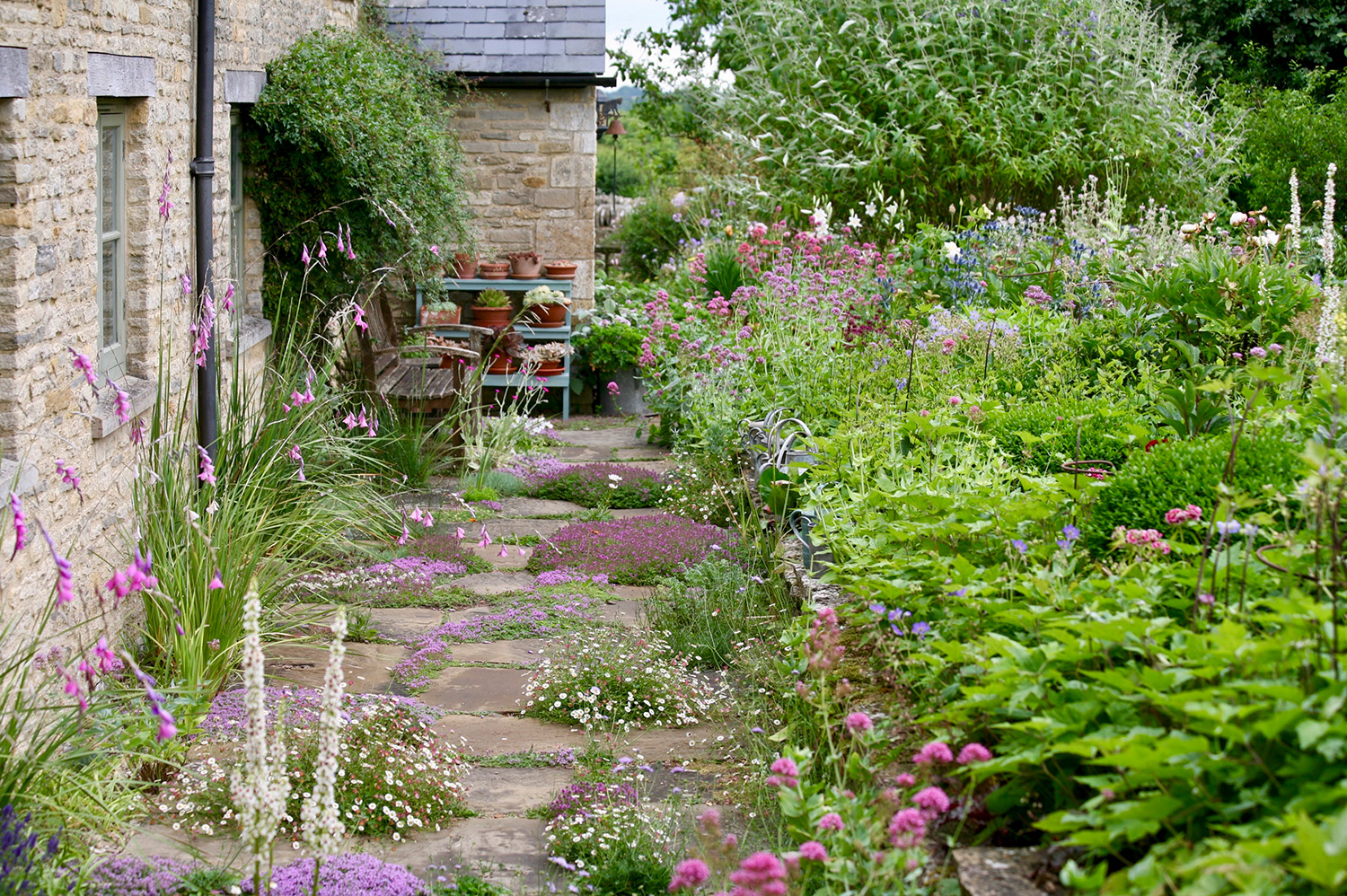
c. Val Bourne
I’m thankful for my two butterfly hotspots. One of them is in front of the south-facing wall of the cottage. We have matt-forming thymes in the crevices of the stone paving and small tortoiseshells, small coppers and gatekeepers are feeding on the carpet of tiny mauve-pink flowers. Thymes are wonderful butterfly plants, because aromatic plants produce very concentrated nectar. This sheltered path becomes even more popular when conditions are windy. The dieramas, or angel’s fishing rods, complete the summer-soft picture. They’re flowering four weeks earlier than they used to as well. Their funnel-shaped bells give dierama its Latin name, for it translates funnel. They are visited by bees: butterflies pass them by.
The other butterfly hotspot is a path lined with a small blue scabious, Scabiosa columbaria, and this is also flowering earlier than it did. The small scabious is easily grown from seed and it’s a British native found on chalky or limestone ground, including the Cotswolds. Native plants suit our pollinators really well, because they’ve evolved together for millennia. I adore this tiny scabious, with its bobbly pale-blue flowers held on wiry stems above highly divided foliage. It’s so delicate, like a lace collar on a plain dress, and it will stay in flower for many weeks, if deadheaded.
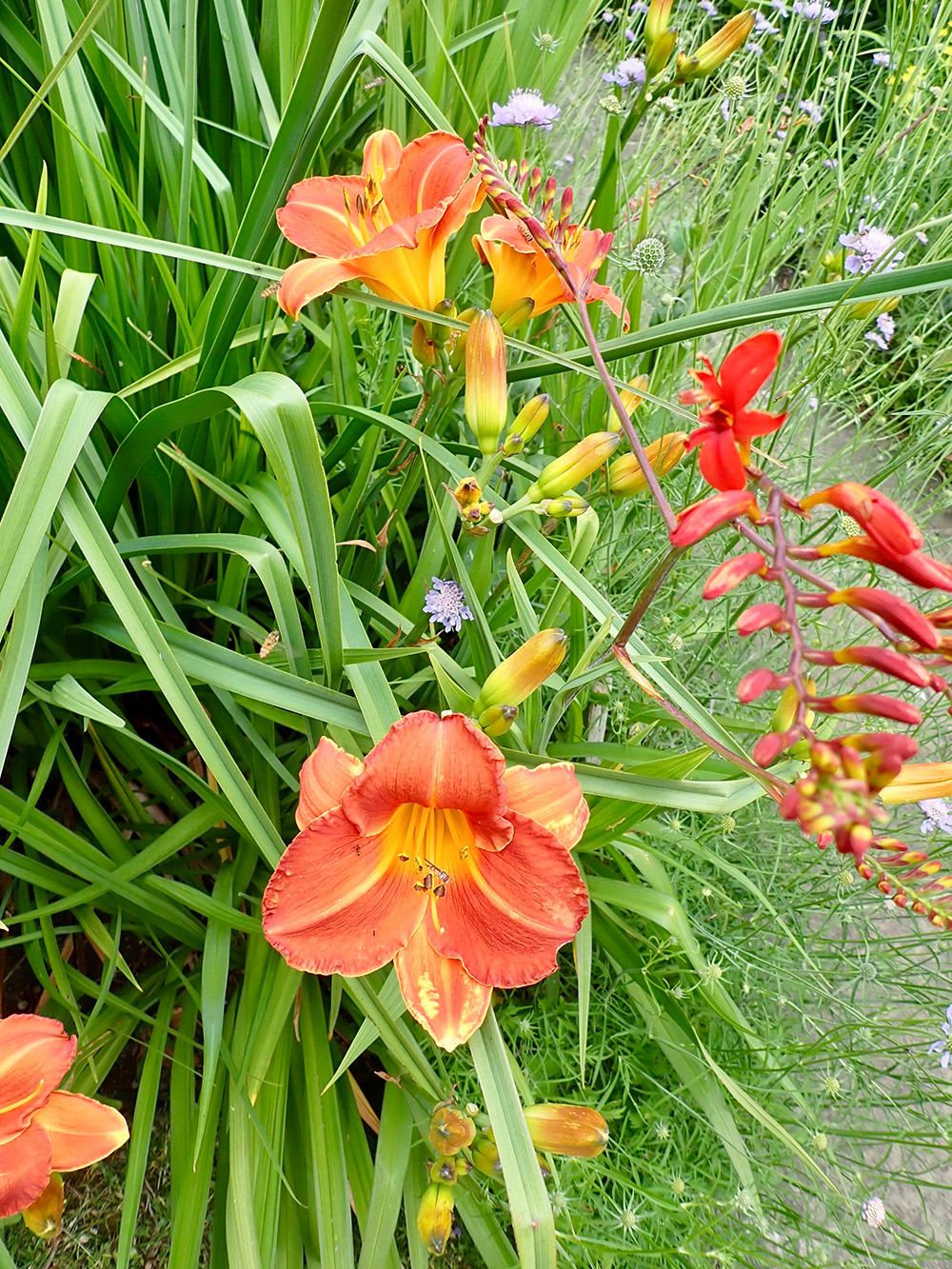
c. Val Bourne
All scabious-like flowers are good for pollinators because the nectar supply is protected by a canopy of hairs. Heavy rainfall doesn’t dilute the nectar and strong sunshine is also deflected by the network of hairs above the nectar supply. We’ve had some small copper butterflies on this scabious and we didn’t see any during last year’s dismal summer. The pale blue pincushions are providing a great contrast against orange-red crocosmias and an orange hemerocallis called ‘Flasher’. All three are doing well, without being watered, despite the dry conditions.
Daylilies, the common name for hemerocallis, did badly last year due to the lack of sunshine. This year, they’re fantastic. Perhaps their year off did them good! I may try it. I’m fussy about daylilies. I prefer single-coloured flowers with an elegant air. I love a lucid-yellow one called ‘Whichford’, which was raised by Harry Randall in 1960. He also named ‘Stafford’ and ‘Stoke Poges’, although he was actually based in Woking in Surrey. (Not sure what that says about Woking) ‘Whichford’ lost its AGM award and, I understand from speaking to one of the panel members who rescinded the Award of Garden Merit, that part of that decision was based on the fact that garden writers (like me) kept on recommending it when we should have been mentioning newer yellows.
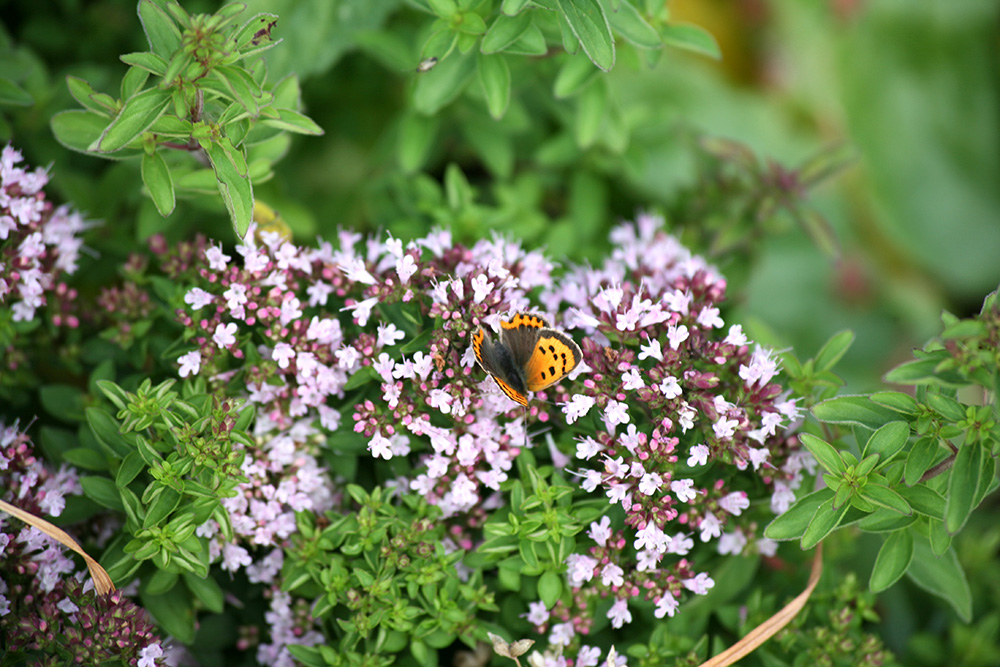
c. Val Bourne
However, I will continue to extol the virtues of ‘Whichford’, because it forms a tight clump and its foliage is darkly shaded at the base. Better still, it stays looking good late into the year. I took ‘Green Flutter’ up, because the foliage was so shabby after flowering was over. Another fabulous daylily is ‘Red Precious’, a tomato-red that flowers reliably every year. It’s three weeks later than ‘Whichford’. ‘Red Precious’ raised by Robert Coe of Buckinghamshire in 1968. It has still got an AGM, despite being an oldie, but it’s really hard to find. Cotswold Garden Flowers and Norwell Nurseries both sell this. If you haven’t been to Norwell Nurseries, near Newark in Nottinghamshire, do go. Be aware that they close in August though.
Two burnt-orange daylilies also feature in my garden, ‘Flasher’ and ‘Primal Scream’. The latter has an AGM. Another is a deliciously dark one called ‘Father James Foster’, but doesn’t seem to be available. Polly’s Daylilies have an excellent list. If summers continue to produce heatwaves on a regular basis, we will all have to rely on drought-busting plants like Hemerocallis.
I have a chequered history with daylilies because, in 2003, I did an article comparing the highly bred triploids from America against the more elegant and refined British-bred daylilies. I stirred up a hornet’s nest, unknowingly, because respected plantsman Graham Stuart Thomas loathed the American thick-petalled varieties and had said so. He liked the more elegant ones. His comments had gone down badly with some members of the British Hosta and Hemerocallis Society and they were on the warpath and I got caught in the crossfire. My editor called my article Overgrown, over bright and over here and you can still find it on The Telegraph website. I got letters, very rude letters, and pleased no one. Thank God, it was before the age of adding comments on the internet – otherwise they’d still be there!











